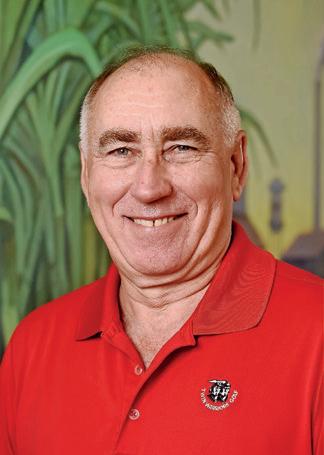
2 minute read
CHARLEY RICHARD SHARES A LIFETIME OF SUGAR KNOWLEDGE, FROM CANE AND BEETS
from Sugarbeet May 2022
by agweek
BY LAURA RUTHERFORD
“However, I chose to go into agriculture, knowing this was my calling,” Richard said. “I was determined to work toward making life easier and more efficient for sugarcane farmers through better varieties and management practices.”
CHARLEY RICHARDS
Roughly half of sugar grown in the United States comes from sugarbeets and the other half comes from sugarcane. Sugar, or sucrose, is a carbohydrate that occurs naturally in fruits, vegetables and other agricultural crops, but at greater levels from sugarbeets and sugarcane. While the sugar from beets and cane is identical, the two plants are very different. Few people know both crops as well as Charley Richard (pronounced Ree-shard) of New Orleans, Louisiana, who works in both the beet and cane side of the American sugar industry.
Richard grew up on the Greenwood and Orange Grove Plantations near Thibodaux, Louisiana, both of which were owned by Southdown Sugars. His father was a farmer and plantation overseer for the company, and his grandfather was a mechanic. Richard’s favorite childhood memories include riding his bicycle through the cane fields, fishing in the canals, and riding on a plow pulled by a mule.
Richard’s father worked outside all year in heat and cold. After Richard graduated from high school, his mother suggested he go into accounting or some other occupation in a climate-controlled building.
Richard received a Bachelor of Science degree in plant science from Nicholls State University in Thibodaux in 1970. He went on to receive a Master of Science degree in 1972 and a Ph.D. in agronomy in 1975 from Louisiana State University. Richard worked in the sugarcane breeding program there and wrote a dissertation titled, “Genetic Inheritance of Sucrose Content in Sugarcane.”
“I quickly recognized that the sugar industry was truly unique because it was so different in all aspects from all of the other crops I studied in school,” he said. “The uniqueness of the genetics of sugarcane, planting and cultural practices, harvesting techniques and equipment used made it even more appealing to work in this industry.”
In 1977, Richard left the LSU sugarcane breeding program and started work as an agronomist with the American Sugar Cane League.

“This was much more to my liking because I was still working in the breeding program but was employed by the industry rather than by government,” Richard said.
When Richard’s mentor and boss Lloyd Lauden retired in 1985, Richard was moved to director of research and field representative of the ASCL. In 1993, he became vice president and director of research. During this time, his work continued in the sugarcane breeding program along with seed increase of potential new varieties. Richard also researched various other topics including cultural practices, fertilizer application, mechanical planting, mechanical harvesting improvements, improving cane quality, cane payment systems, cane processing practices and sugar manufacture. He worked alongside Tom Schwartz with the Sugar Beet Development Council and spent considerable time lobbying for additional research funds for both cane and beets.
“It was then that I began to seriously learn more about the sugarbeet industry and how it was both different and similar to cane,” Richard said.
In 2001, Richard left his position with the ASCL and founded a consulting business called C. Richard & Associates.
“Some of my first endeavors were to develop energy as well as sugar from sugarcane. One of these, in Brawley, California, was a project to produce sugarcane in the desert along with sugarbeets and both would have been processed at the same retrofitted facility,” he said. “Over a period of several years, we had managed to produce more than 200 acres of sugarcane, much of it










